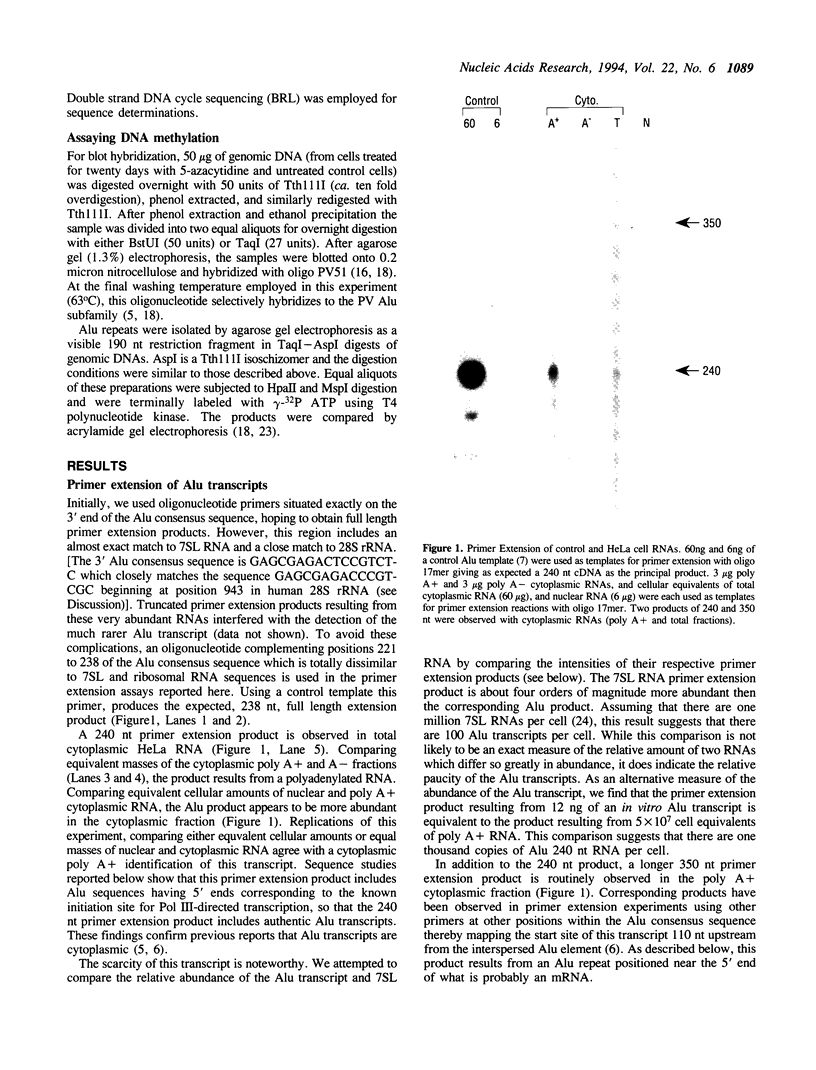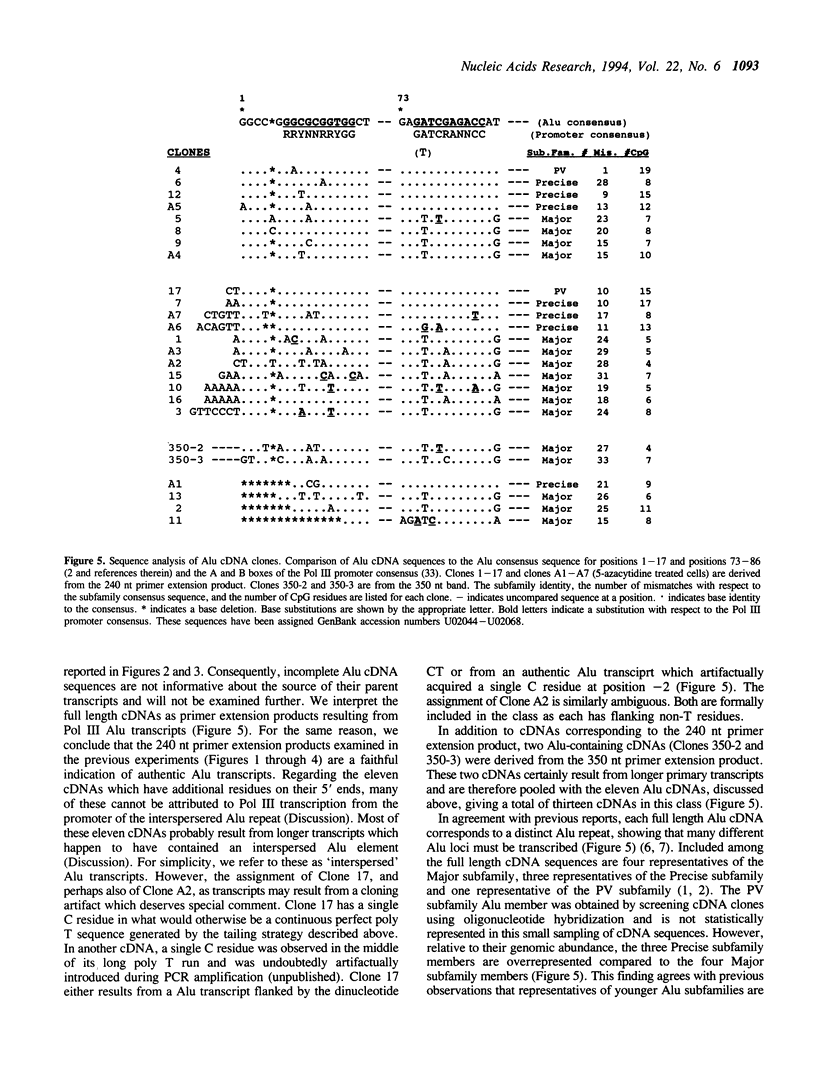Abstract
Full length Alu transcripts in HeLa cells are detected by primer extension using reverse transcriptase and are also analyzed as cloned cDNA sequences. The 5' end of these transcripts corresponds to the transcriptional start site for RNA polymerase III indicating that these RNAs are transcribed from their internal polymerase III promoters. The Alu transcripts found in cytoplasmic poly A+ RNAs appear to be organized into RNPs as assayed by sucrose gradient sedimentation. Present at about one hundred to one thousand copies per cell, the Alu transcripts are rare as compared to 7SL RNA. In agreement with previous reports that methylation inhibits Pol III-directed transcription of Alu in vitro, treatment of HeLa cells with 5-azacytidine results in Alu DNA hypomethylation and an increase in the abundance of the Alu transcript. Sequence analysis shows that many different Alu repeats including members of all subfamilies are transcribed by Pol III in vivo. cDNA sequences of the Pol III-directed transcripts exactly match the A box of the Pol III promoter element whereas in other Alu transcripts this element is not faithfully conserved.
Full text
PDF








Images in this article
Selected References
These references are in PubMed. This may not be the complete list of references from this article.
- Andrews P. G., Kole R. Alu RNA transcribed in vitro binds the 68-kDa subunit of the signal recognition particle. J Biol Chem. 1987 Feb 25;262(6):2908–2912. [PubMed] [Google Scholar]
- Bird A. The essentials of DNA methylation. Cell. 1992 Jul 10;70(1):5–8. doi: 10.1016/0092-8674(92)90526-i. [DOI] [PubMed] [Google Scholar]
- Bredow S., Sürig D., Müller J., Kleinert H., Benecke B. J. Activating-transcription-factor (ATF) regulates human 7S L RNA transcription by RNA polymerase III in vivo and in vitro. Nucleic Acids Res. 1990 Dec 11;18(23):6779–6784. doi: 10.1093/nar/18.23.6779. [DOI] [PMC free article] [PubMed] [Google Scholar]
- Chang D. Y., Maraia R. J. A cellular protein binds B1 and Alu small cytoplasmic RNAs in vitro. J Biol Chem. 1993 Mar 25;268(9):6423–6428. [PubMed] [Google Scholar]
- Deininger P. L., Batzer M. A., Hutchison C. A., 3rd, Edgell M. H. Master genes in mammalian repetitive DNA amplification. Trends Genet. 1992 Sep;8(9):307–311. doi: 10.1016/0168-9525(92)90262-3. [DOI] [PubMed] [Google Scholar]
- Elder J. T., Pan J., Duncan C. H., Weissman S. M. Transcriptional analysis of interspersed repetitive polymerase III transcription units in human DNA. Nucleic Acids Res. 1981 Mar 11;9(5):1171–1189. doi: 10.1093/nar/9.5.1171. [DOI] [PMC free article] [PubMed] [Google Scholar]
- Englander E. W., Wolffe A. P., Howard B. H. Nucleosome interactions with a human Alu element. Transcriptional repression and effects of template methylation. J Biol Chem. 1993 Sep 15;268(26):19565–19573. [PubMed] [Google Scholar]
- Foster R., Jahroudi N., Gedamu L. 5-Azacytidine increases the total cellular copper content and basal level metallothionein mRNA accumulation of human Hep G2 cells. Biochim Biophys Acta. 1991 Mar 26;1088(3):373–379. doi: 10.1016/0167-4781(91)90127-8. [DOI] [PubMed] [Google Scholar]
- Fuhrman S. A., Deininger P. L., LaPorte P., Friedmann T., Geiduschek E. P. Analysis of transcription of the human Alu family ubiquitous repeating element by eukaryotic RNA polymerase III. Nucleic Acids Res. 1981 Dec 11;9(23):6439–6456. doi: 10.1093/nar/9.23.6439. [DOI] [PMC free article] [PubMed] [Google Scholar]
- Hellmann-Blumberg U., Hintz M. F., Gatewood J. M., Schmid C. W. Developmental differences in methylation of human Alu repeats. Mol Cell Biol. 1993 Aug;13(8):4523–4530. doi: 10.1128/mcb.13.8.4523. [DOI] [PMC free article] [PubMed] [Google Scholar]
- Jang K. L., Latchman D. S. HSV infection induces increased transcription of Alu repeated sequences by RNA polymerase III. FEBS Lett. 1989 Dec 4;258(2):255–258. doi: 10.1016/0014-5793(89)81667-9. [DOI] [PubMed] [Google Scholar]
- Kochanek S., Renz D., Doerfler W. DNA methylation in the Alu sequences of diploid and haploid primary human cells. EMBO J. 1993 Mar;12(3):1141–1151. doi: 10.1002/j.1460-2075.1993.tb05755.x. [DOI] [PMC free article] [PubMed] [Google Scholar]
- Leeflang E. P., Liu W. M., Chesnokov I. N., Schmid C. W. Phylogenetic isolation of a human Alu founder gene: drift to new subfamily identity [corrected]. J Mol Evol. 1993 Dec;37(6):559–565. doi: 10.1007/BF00182741. [DOI] [PubMed] [Google Scholar]
- Liu W. M., Leeflang E. P., Schmid C. W. Unusual sequences of two old, inactive human Alu repeats. Biochim Biophys Acta. 1992 Oct 20;1132(3):306–308. doi: 10.1016/0167-4781(92)90165-v. [DOI] [PubMed] [Google Scholar]
- Liu W. M., Schmid C. W. Proposed roles for DNA methylation in Alu transcriptional repression and mutational inactivation. Nucleic Acids Res. 1993 Mar 25;21(6):1351–1359. doi: 10.1093/nar/21.6.1351. [DOI] [PMC free article] [PubMed] [Google Scholar]
- Maraia R. J., Driscoll C. T., Bilyeu T., Hsu K., Darlington G. J. Multiple dispersed loci produce small cytoplasmic Alu RNA. Mol Cell Biol. 1993 Jul;13(7):4233–4241. doi: 10.1128/mcb.13.7.4233. [DOI] [PMC free article] [PubMed] [Google Scholar]
- Maraia R. J. The subset of mouse B1 (Alu-equivalent) sequences expressed as small processed cytoplasmic transcripts. Nucleic Acids Res. 1991 Oct 25;19(20):5695–5702. doi: 10.1093/nar/19.20.5695. [DOI] [PMC free article] [PubMed] [Google Scholar]
- Matera A. G., Hellmann U., Schmid C. W. A transpositionally and transcriptionally competent Alu subfamily. Mol Cell Biol. 1990 Oct;10(10):5424–5432. doi: 10.1128/mcb.10.10.5424. [DOI] [PMC free article] [PubMed] [Google Scholar]
- Monk M., Boubelik M., Lehnert S. Temporal and regional changes in DNA methylation in the embryonic, extraembryonic and germ cell lineages during mouse embryo development. Development. 1987 Mar;99(3):371–382. doi: 10.1242/dev.99.3.371. [DOI] [PubMed] [Google Scholar]
- Murphy M. H., Baralle F. E. Directed semisynthetic point mutational analysis of an RNA polymerase III promoter. Nucleic Acids Res. 1983 Nov 25;11(22):7695–7700. doi: 10.1093/nar/11.22.7695. [DOI] [PMC free article] [PubMed] [Google Scholar]
- Panning B., Smiley J. R. Activation of RNA polymerase III transcription of human Alu repetitive elements by adenovirus type 5: requirement for the E1b 58-kilodalton protein and the products of E4 open reading frames 3 and 6. Mol Cell Biol. 1993 Jun;13(6):3231–3244. doi: 10.1128/mcb.13.6.3231. [DOI] [PMC free article] [PubMed] [Google Scholar]
- Paulson K. E., Schmid C. W. Transcriptional inactivity of Alu repeats in HeLa cells. Nucleic Acids Res. 1986 Aug 11;14(15):6145–6158. doi: 10.1093/nar/14.15.6145. [DOI] [PMC free article] [PubMed] [Google Scholar]
- Schmid C. W. Human Alu subfamilies and their methylation revealed by blot hybridization. Nucleic Acids Res. 1991 Oct 25;19(20):5613–5617. doi: 10.1093/nar/19.20.5613. [DOI] [PMC free article] [PubMed] [Google Scholar]
- Schmid C., Maraia R. Transcriptional regulation and transpositional selection of active SINE sequences. Curr Opin Genet Dev. 1992 Dec;2(6):874–882. doi: 10.1016/s0959-437x(05)80110-8. [DOI] [PubMed] [Google Scholar]
- Sinnett D., Richer C., Deragon J. M., Labuda D. Alu RNA transcripts in human embryonal carcinoma cells. Model of post-transcriptional selection of master sequences. J Mol Biol. 1992 Aug 5;226(3):689–706. doi: 10.1016/0022-2836(92)90626-u. [DOI] [PubMed] [Google Scholar]
- Snyder R. D., Lachmann P. J. Differential effects of 5-azacytidine and 5-azadeoxycytidine on cytotoxicity, DNA-strand breaking and repair of X-ray-induced DNA damage in HeLa cells. Mutat Res. 1989 Jul;226(3):185–190. doi: 10.1016/0165-7992(89)90018-3. [DOI] [PubMed] [Google Scholar]
- Strub K., Moss J., Walter P. Binding sites of the 9- and 14-kilodalton heterodimeric protein subunit of the signal recognition particle (SRP) are contained exclusively in the Alu domain of SRP RNA and contain a sequence motif that is conserved in evolution. Mol Cell Biol. 1991 Aug;11(8):3949–3959. doi: 10.1128/mcb.11.8.3949. [DOI] [PMC free article] [PubMed] [Google Scholar]
- Swanstrom R., Varmus H. E., Bishop J. M. The terminal redundancy of the retrovirus genome facilitates chain elongation by reverse transcriptase. J Biol Chem. 1981 Feb 10;256(3):1115–1121. [PubMed] [Google Scholar]
- Weiner A. M., Deininger P. L., Efstratiadis A. Nonviral retroposons: genes, pseudogenes, and transposable elements generated by the reverse flow of genetic information. Annu Rev Biochem. 1986;55:631–661. doi: 10.1146/annurev.bi.55.070186.003215. [DOI] [PubMed] [Google Scholar]
- Willard C., Nguyen H. T., Schmid C. W. Existence of at least three distinct Alu subfamilies. J Mol Evol. 1987;26(3):180–186. doi: 10.1007/BF02099850. [DOI] [PubMed] [Google Scholar]






